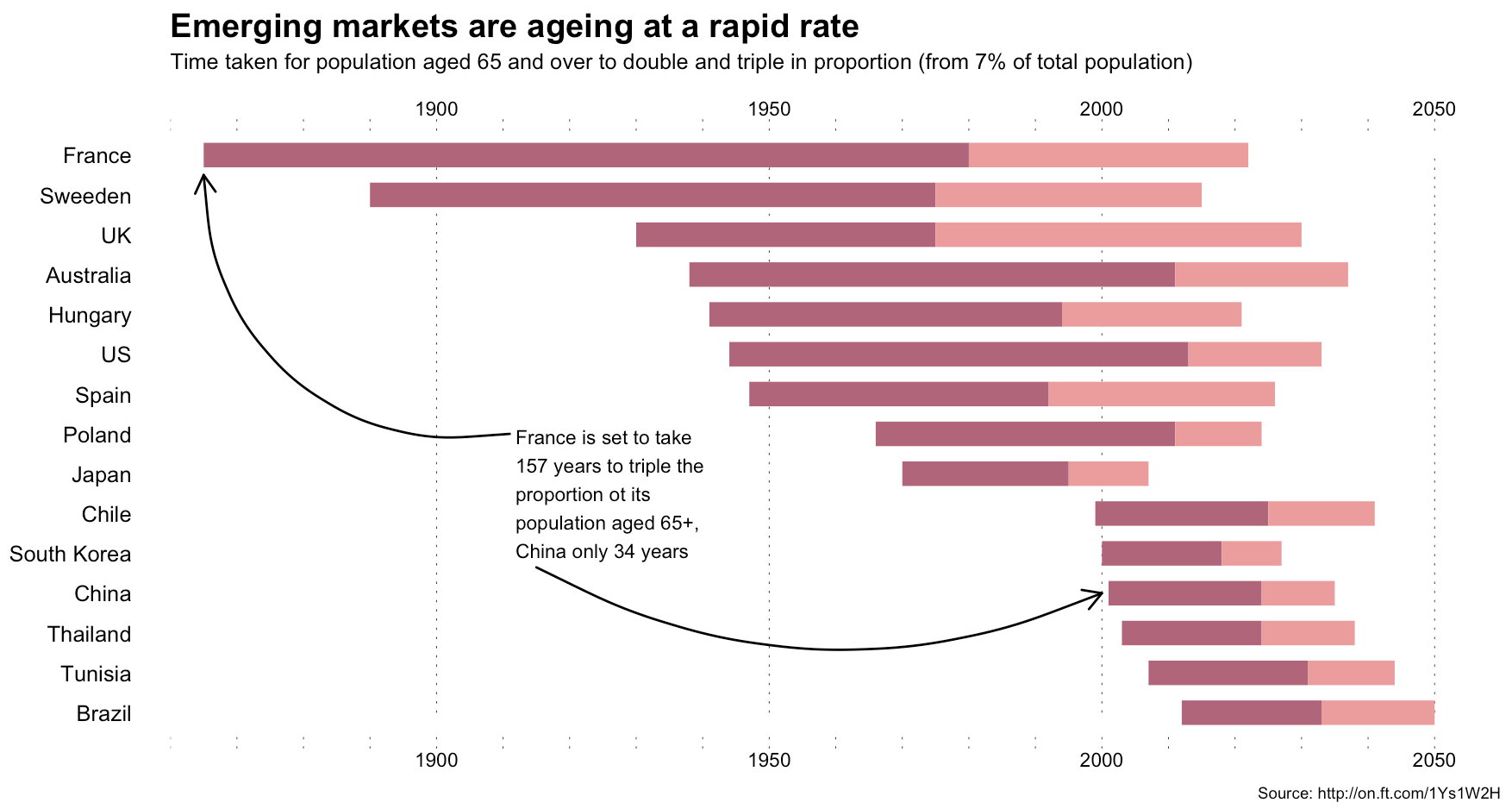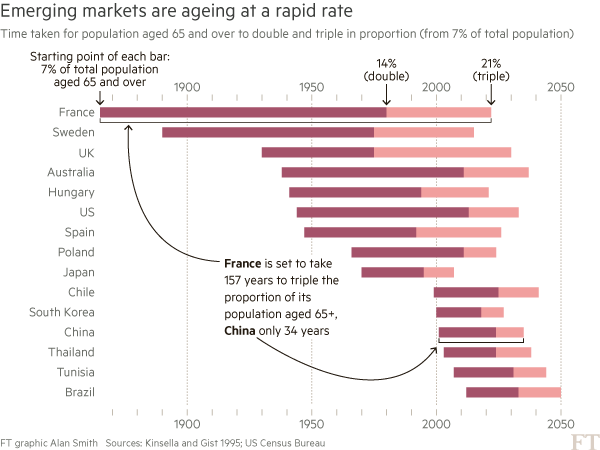Your data vis “Spidey-sense” & the need for a robust “utility belt”
@theboysmithy did a great piece on coming up with an alternate view for a timeline for an FT piece.
Here’s an excerpt (read the whole piece, though, it’s worth it):
Here is an example from a story recently featured in the FT: emerging- market populations are expected to age more rapidly than those in developed countries. The figures alone are compelling: France is expected to take 157 years (from 1865 to 2022) to triple the proportion of its population aged over 65, from 7 per cent to 21 per cent; for China, the equivalent period is likely to be just 34 years (from 2001 to 2035).
You may think that visualising this story is as simple as creating a bar chart of the durations ordered by length. In fact, we came across just such a chart from a research agency.
But, to me, this approach generates “the feeling” — and further scrutiny reveals specific problems. A reader must work hard to memorise the date information next to the country labels to work out if there is a relationship between the start date and the length of time taken for the population to age. The chart is clearly not ideal, but how do we improve it?
Alan went on to talk about the process of improving the vis, eventually turning to Joseph Priestly for inspiration. Here’s their makeover:
Alan used D3 to make this, which had me head scratching for a bit. Bostock is genius & I :heart: D3 immensely, but I never really thought of it as a “canvas” for doing general data visualization creation for something like a print publication (it’s geared towards making incredibly data-rich interactive visualizations). It’s 100% cool to do so, though. It has fine-grained control over every aspect of a visualization and you can easily turn SVGs into PDFs or use them in programs like Illustrator to make the final enhancements. However, D3 is not the only tool that can make a chart like this.
I made the following in R (of course):

The annotations in Alan’s image were (99% most likely) made with something like Illustrator. I stopped short of fully reproducing the image (life is super-crazy, still), but could have done so (the entire image is one ggplot2 object).
This isn’t an “R > D3” post, though, since I use both. It’s about (a) reinforcing Alan’s posits that we should absolutely take inspiration from historical vis pioneers (so read more!) + need a diverse visualization “utility belt” (ref: Batman) to ensure you have the necessary tools to make a given visualization; (b) trusting your “Spidey-sense” when it comes to evaluating your creations/decisions; and, (c) showing that R is a great alternative to D3 for something like this :-)
Spider-man (you expected headier references from a dude with a shield avatar?) has this ability to sense danger right before it happens and if you’re making an effort to develop and share great visualizations, you definitely have this same sense in your DNA (though I would not recommend tossing pie charts at super-villains to stop them). When you’ve made something and it just doesn’t “feel right”, look to other sources of inspiration or reach out to your colleagues or the community for ideas or guidance. You can and do make awesome things, and you do have a “Spidey-sense”. You just need to listen to it more, add depth and breadth to your “utility belt” and keep improving with each creation you release into the wild.
R code for the ggplot vis reproduction is below, and it + the CSV file referenced are in this gist.
library(ggplot2)
library(dplyr)
ft <- read.csv("ftpop.csv", stringsAsFactors=FALSE)
arrange(ft, start_year) %>%
mutate(country=factor(country, levels=c(" ", rev(country), " "))) -> ft
ft_labs <- data_frame(
x=c(1900, 1950, 2000, 2050, 1900, 1950, 2000, 2050),
y=c(rep(" ", 4), rep(" ", 4)),
hj=c(0.5, 0.5, 0.5, 0.5, 0.5, 0.5, 0.5, 0.5),
vj=c(1, 1, 1, 1, 0, 0, 0, 0)
)
ft_lines <- data_frame(x=c(1900, 1950, 2000, 2050))
ft_ticks <- data_frame(x=seq(1860, 2050, 10))
gg <- ggplot()
# tick marks & gridlines
gg <- gg + geom_segment(data=ft_lines, aes(x=x, xend=x, y=2, yend=16),
linetype="dotted", size=0.15)
gg <- gg + geom_segment(data=ft_ticks, aes(x=x, xend=x, y=16.9, yend=16.6),
linetype="dotted", size=0.15)
gg <- gg + geom_segment(data=ft_ticks, aes(x=x, xend=x, y=1.1, yend=1.4),
linetype="dotted", size=0.15)
# double & triple bars
gg <- gg + geom_segment(data=ft, size=5, color="#b0657b",
aes(x=start_year, xend=start_year+double, y=country, yend=country))
gg <- gg + geom_segment(data=ft, size=5, color="#eb9c9d",
aes(x=start_year+double, xend=start_year+double+triple, y=country, yend=country))
# tick labels
gg <- gg + geom_text(data=ft_labs, aes(x, y, label=x, hjust=hj, vjust=vj), size=3)
# annotations
gg <- gg + geom_label(data=data.frame(), hjust=0, label.size=0, size=3,
aes(x=1911, y=7.5, label="France is set to take\n157 years to triple the\nproportion ot its\npopulation aged 65+,\nChina only 34 years"))
gg <- gg + geom_curve(data=data.frame(), aes(x=1911, xend=1865, y=9, yend=15.5),
curvature=-0.5, arrow=arrow(length=unit(0.03, "npc")))
gg <- gg + geom_curve(data=data.frame(), aes(x=1915, xend=2000, y=5.65, yend=5),
curvature=0.25, arrow=arrow(length=unit(0.03, "npc")))
# pretty standard stuff here
gg <- gg + scale_x_continuous(expand=c(0,0), limits=c(1860, 2060))
gg <- gg + scale_y_discrete(drop=FALSE)
gg <- gg + labs(x=NULL, y=NULL, title="Emerging markets are ageing at a rapid rate",
subtitle="Time taken for population aged 65 and over to double and triple in proportion (from 7% of total population)",
caption="Source: http://on.ft.com/1Ys1W2H")
gg <- gg + theme_minimal()
gg <- gg + theme(axis.text.x=element_blank())
gg <- gg + theme(panel.grid=element_blank())
gg <- gg + theme(plot.margin=margin(10,10,10,10))
gg <- gg + theme(plot.title=element_text(face="bold"))
gg <- gg + theme(plot.subtitle=element_text(size=9.5, margin=margin(b=10)))
gg <- gg + theme(plot.caption=element_text(size=7, margin=margin(t=-10)))
ggYour data vis “Spidey-sense” & the need for a robust “utility belt”的更多相关文章
- Fitting Bayesian Linear Mixed Models for continuous and binary data using Stan: A quick tutorial
I want to give a quick tutorial on fitting Linear Mixed Models (hierarchical models) with a full var ...
- Machine Learning and Data Mining(机器学习与数据挖掘)
Problems[show] Classification Clustering Regression Anomaly detection Association rules Reinforcemen ...
- JavaScript资源大全中文版(Awesome最新版)
Awesome系列的JavaScript资源整理.awesome-javascript是sorrycc发起维护的 JS 资源列表,内容包括:包管理器.加载器.测试框架.运行器.QA.MVC框架和库.模 ...
- PCI Express(四) - The transaction layer
原文出处:http://www.fpga4fun.com/PCI-Express4.html 感觉没什么好翻译的,都比较简单,主要讲了TLP的帧结构 In the transaction layer, ...
- Task schedule 分类: 比赛 HDU 查找 2015-08-08 16:00 2人阅读 评论(0) 收藏
Task schedule Time Limit: 2000/1000 MS (Java/Others) Memory Limit: 32768/32768 K (Java/Others) Total ...
- Doubles 分类: POJ 2015-06-12 18:24 11人阅读 评论(0) 收藏
Doubles Time Limit: 1000MS Memory Limit: 10000K Total Submissions: 19954 Accepted: 11536 Descrip ...
- codevs 3732 解方程
神题不可言会. f(x+p)=f(x)(mod p) #include<iostream> #include<cstdio> #include<cstring> # ...
- notes: the architecture of GDB
1. gdb structure at the largest scale,GDB can be said to have two sides to it:1. The "symbol si ...
- poj 2531 Network Saboteur(经典dfs)
题目大意:有n个点,把这些点分别放到两个集合里,在两个集合的每个点之间都会有权值,求可能形成的最大权值. 思路:1.把这两个集合标记为0和1,先默认所有点都在集合0里. 2 ...
随机推荐
- ELK日志分析系统的应用
收集和分析日志是应用开发中至关重要的一环,互联网大规模.分布式的特性决定了日志的源头越来越分散, 产生的速度越来越快,传统的手段和工具显得日益力不从心.在规模化场景下,grep.awk 无法快速发挥作 ...
- 微信小程序入门学习
前(che)言(dan): 近几天,微信小程序的内测引起了众多开发人员的热议,很多人都认为这将会成为一大热门,那么好吧,虽然我是一个小白,但这是个新玩意,花点时间稍稍钻研一下也是无妨的,谁让我没有女朋 ...
- canvas绘制一定数目的圆(均分)
绘制多圆 2016年5月24日12:12:26 绘制一定数目(num)颜色随机的小圆,围成一个大圆.根据num完全自动生成,且小圆自动均分大圆路径(num≥20). 效果: 前置技能:(1).Canv ...
- Jquery Validation 验证控件的使用说明
转载自:http://blog.csdn.net/huang100qi/article/details/52453970,做了一些简化及修改 下载地址:https://jqueryvalidation ...
- 【Spark2.0源码学习】-2.一切从脚本说起
从脚本说起 在看源码之前,我们一般会看相关脚本了解其初始化信息以及Bootstrap类,Spark也不例外,而Spark我们启动三端使用的脚本如下: %SPARK_HOME%/sbin/st ...
- 【Android】再来一篇Fragment懒加载(只加载一次哦)
效果 老规矩,先来看看效果图 没错,我又入坑了,又重新做了个 Gank 客户端,因为之前那个代码写得太烂了,这次有好好的考虑了下架构之类的事,代码应该会更容易读懂了点了,吧.哈哈,再次欢迎来 star ...
- Java Tomcat 启动失败的解决思路
好久没写新博文了,离自己要求的每年几篇的目标也是渐行渐远. 最近在学习Java,也是从基础学习,因为我是一个.net开发人员,所以学习的成本相对低些.Java JDK,JRE,Tomact 的安装及配 ...
- 分享一个随机更改 MAC地址 软件
有些软件 是根据 MAC地址 来判断 是不是 已经 安装过 这个 软件 (针对 有些软件是 可以 免费 使用的 ) 要想 一直 使用 的话 只需要 修改一下 mac地址 就可以 继续 使用! 在百度中 ...
- Java集合之Map和Set
以前就知道Set和Map是java中的两种集合,Set代表集合元素无序.不可重复的集合:Map是代表一种由多个key-value对组成的集合.然后两个集合分别有增删改查的方法.然后就迷迷糊糊地用着.突 ...
- 【WPF】学习笔记(一)——做一个简单的电子签名板
参加实习(WPF)已经有两个多周的时间了,踩了一些坑,也算积累了一些小东西,准备慢慢拿出来分享一下.(●'◡'●) 这次呢就讲讲一个简单的电子签名板的实现. 先上张图(PS:字写得比较丑,不要太在意哈 ...


